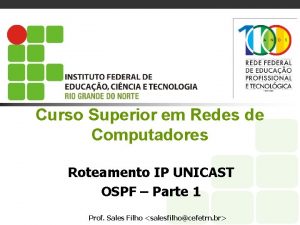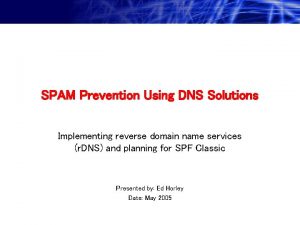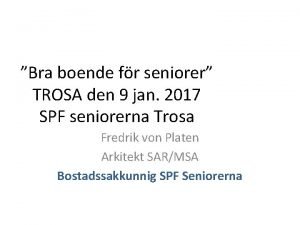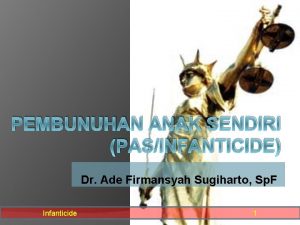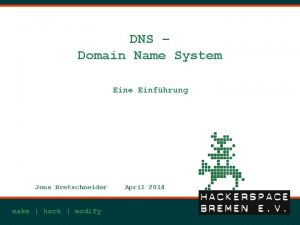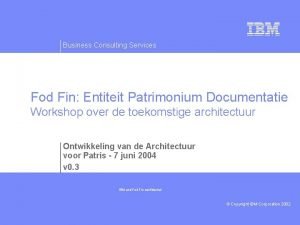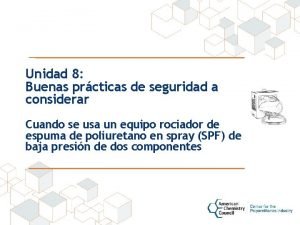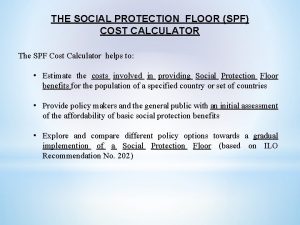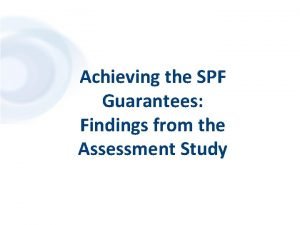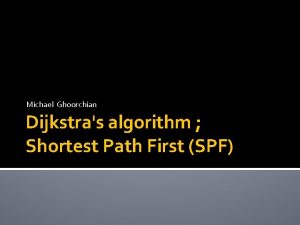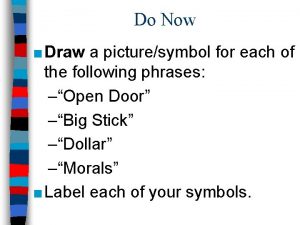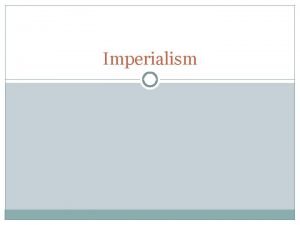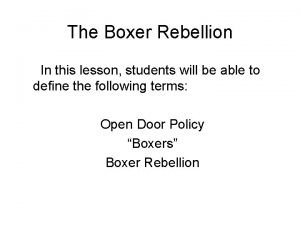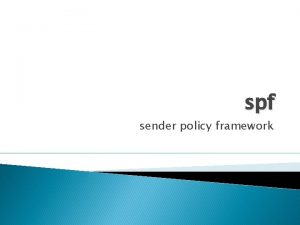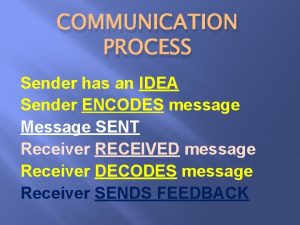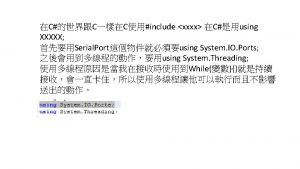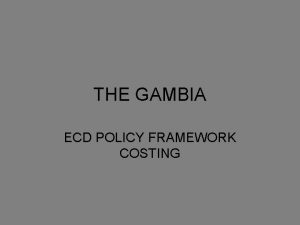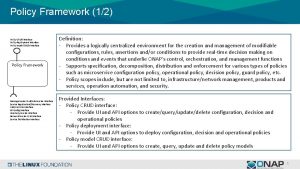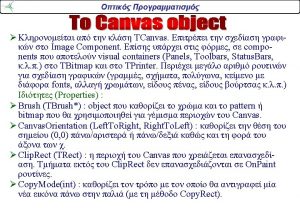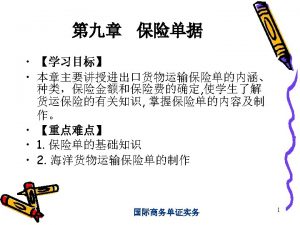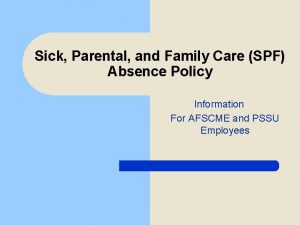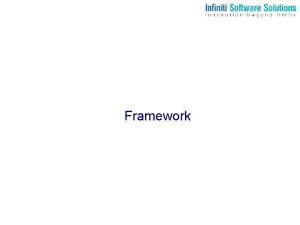spf sender policy framework From Open SPF Note




































- Slides: 36

spf sender policy framework

From Open. SPF Note: http: //www. openspf. org/ is a good reference source for SPF

Explain how SPF works in 1 minute http: //www. openspf. org/FAQ/How_does_it_work � Domains use public records (DNS) to direct requests for different services (web, email, etc. ) to the machines that perform those services ◦ All domains already publish email (MX) records to tell the world what machines receive mail for the domain � SPF works by domains publishing "reverse MX" records to tell the world what machines send mail from the domain ◦ When receiving a message from a domain �Recipient can check those records to make sure mail is coming from where it should be coming from � With SPF, those "reverse MX" records are easy to publish: ◦ One line in DNS is all it takes

What does SPF actually DO? http: //www. openspf. org/FAQ/What_it_does � Spammer forges a hotmail. com address � When the message is sent, you see: ◦ Tries to spam you ◦ They connect from somewhere other than Hotmail ◦ MAIL FROM: forged_address@hotmail. com � Don't have to take his word for it � Ask Hotmail if the IP address comes from their network � (In this example) Hotmail publishes an SPF record � If Hotmail says they recognize the sending machine ◦ That record tells you (your computer) how to find out if the sending machine is allowed to send mail from Hotmail ◦ It passes � You can assume the sender is who they say they are ◦ If the message fails SPF tests � It's a forgery ◦ That's how you can tell it's probably a spammer

sender policy framework � Client validation system � Verifies envelope sender is permitted to send mail on behalf of the domain ◦ In practice, only verifies IP address � Aims to prevent rogue mail servers � SPF provides no information about the contents of an email

how spf works � SPF is stored in DNS � An SPF record type is available ◦ Its use is not widespread �RFC 4408 ◦ Deprecated in 2014? �RFC 7208 ◦ RFC 7372? � Using a TXT record is more common

how spf works � An SPF record designates permitted and rejected sender(s) for a domain � Mail from a non-permitted sender may be safely rejected

what spf checks � SPF evaluation performed on two pieces of information ◦ Client email address ◦ Client IP address � Client email is retrieved or derived from: ◦ Envelope sender (MAIL FROM) ◦ HELO/EHLO host name

what spf checks � Evaluation is always performed on envelope sender � Evaluation should be performed twice if envelope sender and HELO domains differ ◦ The RFC is unclear on how to merge the results of the evaluations ◦ Likely that the ‘best’ outcome is accepted

reading spf records (spf or txt record) � Always start with ‘v=spf 1’ � Read left-to right � Evaluation stops when a mechanism is matched � Last element of a SPF record should always be an ‘all’ or a ‘redirect’ � If no mechanisms are matched, the result returned is ‘Neutral’

3 example spf records (lines are wrapped) gmail. com. 300 IN TXT "v=spf 1 redirect=_spf. google. com" _spf. google. com. 107 IN TXT "v=spf 1 ip 4: 216. 239. 32. 0/19 ip 4: 64. 233. 160. 0/19 ip 4: 66. 249. 80. 0/20 ip 4: 72. 14. 192. 0/18 ip 4: 209. 85. 128. 0/17 ip 4: 66. 102. 0. 0/20 ip 4: 74. 125. 0. 0/16 ip 4: 64. 18. 0. 0/20 ip 4: 207. 126. 144. 0/20 ip 4: 173. 194. 0. 0/16 ? all” hotmail. com. 3600 IN TXT "v=spf 1 include: spf-a. hotmail. com include: spf-b. hotmail. com include: spf-c. hotmail. com include: spfd. hotmail. com ~all“

spf mechanisms � ALL ◦ Matches anything �A ◦ Matches if client IP matches one of the IP addresses of the named domain ◦ Performs DNS lookup on named domain �Looks for A record if client IP is IPv 4 �AAAA if client IP is IPv 6

spf mechanisms � IP 4, IP 6 ◦ Matches if client IP is in the named netblock ◦ Variants for IPv 4 and IPv 6 ◦ Netblock must in CIDR format �e. g. 172. 16. 1. 0/24

spf mechanisms � MX ◦ Matches if client IP is one of the servers in the MX records of the named domain � PTR ◦ Matches if PTR record for client IP exists and maps to a host in the named domain

spf mechanisms � EXISTS ◦ Matches if the named domain exists ◦ Can be used to emulate DNS blacklists ◦ e. g. �‘v=spf 1 -exists: %{ir}. zen. spamhaus. org’

spf mechanisms � INCLUDE ◦ Matches if the result of the referenced policy was PASS ◦ Name is poorly chosen

spf qualifiers � “+” Pass ◦ Client is permitted to send mail for the domain ◦ Pass is implied if the qualifier is omitted � “–” Fail ◦ Client is not authorized to send mail for the domain

spf qualifiers � “~” Soft. Fail ◦ Client should not send mail for the domain ◦ Mail should not be blocked solely on a Soft. Fail ◦ Result can be used by spam filtering software � “? ” Neutral ◦ No assertion on if client is authorized ◦ Must be treated same as if there were no SPF record

spf modifiers � SPF modifiers ◦ Provide additional information ◦ Do not directly affect the evaluation of SPF records

spf modifiers � redirect ◦ Redirect to a different SPF record ◦ Replaces result of this SPF record ◦ Redirect or All should always be last element of a SPF record

spf modifiers � exp ◦ Provides an explanation of why SPF validation failed to the client ◦ The TXT record is looked up at named domain and its contents is used as the explanation ◦ SPF macros can be used to make the explanation more informative

selected spf macros �A number of macros are available in SPF records � Form: %{some stuff } � Macros are expanded during SPF evaluation � Some stuff: ◦ ◦ s = client email address l = local part of client email address o = domain of client email address h = domain name from HELO or EHLO

selected spf macros � Some stuff (cont. ) ◦ d = client domain name ◦ i = client IP address ◦ v is �"in-addr" �"ip 6" - if client IP is IPv 4 - if client IP is IPv 6 �Used to construct PTR addresses �e. g. �%{ir}. %{v}. arpa

spf macro transformers � Some stuff (cont. ) ◦ r - reverse macro, splitting on ‘. ’ by default �e. g. �%{ir} will reverse an IP address ◦ 0 -128 - number of delimited components to keep ◦ e. g. �if d is ‘www. example. com’ �%{d 2} is ‘example. com’

spf macro delimiters � Allows you to specify a delimiter to be replaced with periods ◦ Available delimiters are in the set �. -+, /_= ◦ e. g. �if l is ‘jwatso 8+foo’ �%{l+} is ‘jwatso 8. foo’

example spf records (redux) gmail. com. 300 IN TXT "v=spf 1 redirect=_spf. google. com" _spf. google. com. 107 IN TXT "v=spf 1 ip 4: 216. 239. 32. 0/19 ip 4: 64. 233. 160. 0/19 ip 4: 66. 249. 80. 0/20 ip 4: 72. 14. 192. 0/18 ip 4: 209. 85. 128. 0/17 ip 4: 66. 102. 0. 0/20 ip 4: 74. 125. 0. 0/16 ip 4: 64. 18. 0. 0/20 ip 4: 207. 126. 144. 0/20 ip 4: 173. 194. 0. 0/16 ? all” hotmail. com. 3600 IN TXT "v=spf 1 include: spf-a. hotmail. com include: spf-b. hotmail. com include: spf-c. hotmail. com include: spf-d. hotmail. com ~all“

spf example

spf header � SMTP servers should add a ‘Received-SPF’ header to any E-Mail where a SPF record was checked � The Received-SPF header should contain the result of the SPF check

Example spf headers Received-SPF: Pass (mybox. example. org: domain of myname@example. com designates 192. 0. 2. 1 as permitted sender) receiver=mybox. example. org; client-ip=192. 0. 2. 1; envelope-from=<myname@example. com>; helo=foo. example. com; Received-SPF: Fail (mybox. example. org: domain of myname@example. com does not designate 192. 0. 2. 1 as permitted sender) identity=mailfrom; client-ip=192. 0. 2. 1; envelope-from=<myname@example. com>;

spf limitations � Only works if everyone uses it � Only prevents mail from unauthorized hosts ◦ Even then only if servers check it � Does not verify the sender, only their domain � Does not verify the contents of a message � SPAM can (and will) still find a way

sender id

sender id � Microsoft Sender ID is a superset of SPF � MS owns the patents ◦ Many open-source projects are wary of implementing it despite Microsoft’s promises

sender id � Sender ◦ mfrom ID has two modes of operation �validates envelope sender, just like SPF ◦ pra �validates Purported Responsible Address

sender id’s pra � Purported Responsible Address ◦ email address of most likely responsible party � Derived by applying heuristics to a number typical E-Mail headers ◦ Defined in RFC 4407

sender id problems � Sender ID violates SPF specification by trying to use a SPF record to verify the PRA � Recommended practice is to add an empty Sender ID PRA record ◦ Prevents evaluation of your SPF record in determining PRA ◦ ‘spf 2. 0/pra ? all’

sender id recommendations (per jason watson) �I do not feel it adds much value to pure SPF � I recommend a neutral PRA record to prevent unintended consequences of Sender ID evaluating your SPF record � mfrom will still evaluate your SPF record in the same manner as pure SPF
 영국 beis
영국 beis Difference between note making and note taking
Difference between note making and note taking Signal words examples
Signal words examples Difference between note making and note taking
Difference between note making and note taking Goods received note vs delivery note
Goods received note vs delivery note Debit note example
Debit note example Debit note là gì
Debit note là gì Relevance of note making
Relevance of note making Simple discount rate formula
Simple discount rate formula Assure natural body wash
Assure natural body wash Algoritmo spf
Algoritmo spf Efax spf record
Efax spf record Thanatology adalah
Thanatology adalah Spf trosa
Spf trosa Simulasi pemilihan formasi
Simulasi pemilihan formasi Ade firmansyah sugiharto
Ade firmansyah sugiharto Strato spf präfix
Strato spf präfix Spf fin fod fin
Spf fin fod fin Carpi volare
Carpi volare Unidad 8 spf
Unidad 8 spf Spfs calculator
Spfs calculator Spf
Spf Glans schijf van vijf
Glans schijf van vijf Yahoo.comah
Yahoo.comah Dijkestra
Dijkestra Combell spf
Combell spf Spf medlemsregister
Spf medlemsregister What is national planning policy framework
What is national planning policy framework Health policy triangle framework
Health policy triangle framework Define open door policy.
Define open door policy. Clifford sifton open door policy
Clifford sifton open door policy Americas open door policy
Americas open door policy Open door policy aim
Open door policy aim How did dollar diplomacy protect the open door policy
How did dollar diplomacy protect the open door policy Indirect and direct control imperialism
Indirect and direct control imperialism The galloping snail political cartoon analysis
The galloping snail political cartoon analysis Boxer rebellion lesson plan
Boxer rebellion lesson plan










